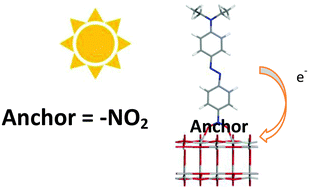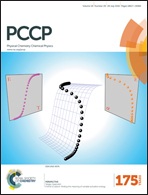Can nitro groups really anchor onto TiO2? Case study of dye-to-TiO2 adsorption using azo dyes with NO2 substituents†
Abstract
The nitro group has recently been suggested as a new type of anchor for dye-sensitized solar cells (DSSCs) and has shown promising optoelectronic properties. Considering the excellent electron withdrawing ability of the nitro group and wider materials selection brought about by this substituent, it is helpful to evaluate the interfacial structures and photophysics of more organic dyes where NO2 poses as the dye-to-TiO2 anchor. A computational study on a family of azo dyes bearing a nitro group is presented, where the effect of certain side groups on their optical properties is examined. Both isolated dye molecules and dye/TiO2 nanocomposites are studied via density functional theory and time-dependent density functional theory, with complementary experimental UV/vis absorption spectroscopy and photovoltaic device testing. Results demonstrate that these nitro-containing dyes prefer a monodentate anchoring mode on a TiO2 cluster. These nitro dyes reveal weak, but non-negligible, adsorption onto TiO2; yet, very low photovoltaic performance once incorporated into a DSSC device. This poor delivery of nitro groups as DSSC anchors is ostensibly inconsistent with previous findings; but is rationalized via the “auxiliary anchor” concept.


 Please wait while we load your content...
Please wait while we load your content...